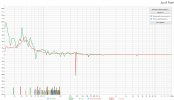MAB
Major Contributor
I have both.Quite a good perspective. You seem to understand my issue.
Why did you choose the Flex balanced vs the SHD? I am leaning toward the SHD only because I think it has the features I need. But I'm not sure.
I use the SHD with to integrate subs with a pair of Genelec mains, and provide room correction.
I have a Flex Balanced I use as electronic crossover and PEQ for a pair of JBL M2.
Both have transparent analog inputs. They have slightly different features and I/O.
I use a Flex Eight for my desktop system. It has no analog input and is unbalanced RCA output only.
I have an HTx that I am building a system around.
I also have several older MiniDSP as well, one that I use in the processor loop of a vintage integrated amp to EQ the speakers in our living room. My wife (who cares not at all about audio) prefers the EQ because the bass is no longer boomy. It's dramatic, and I can partially compensate for some of the room and placement issues in that living space.
Again, my only regret is there aren't multiple competitors to MiniDSP.
For you, it seems the SHD or the Flex Balanced are the way to go. Both are utterly transparent.
Yes, the SFL-3 is one of the lowest noise tube preamps I have ever heard, that being said with very sensitive speakers (>100dB/watt/m) you can hear hiss, but only at very close range. The MiniDSP are quieter. Since I build speakers as a hobby, I do measure and take note of these things, even if none of my gear is very noisy. It's just that the MiniDSP isn't going to the noise limiter in any reasonable system.You mention your system is quieter.
Great. The JBL M2 (which are now finished, and I am building the next version of that system) is one of the mightiest and best sounding speakers I have ever heard. The MiniDSP outperforms my friends massive JBL home theater on tweeter hiss (not that his are a problem, the MiniDSP is quieter, sorry I don't have comparison measurements so you will have to take my word.) I also don't have to deal with putting Crown amps with fans in a closetHow does it sound?
I used to sell audio in the '80s when a steady stream of non-audio objects started being sold. Goldmund produced a version of the TipToe for $180 eachMany on this and on other fora who switched from all analog to digital complain about sterility of the sound. I will have to say that my CD/SACD player (Oppo BDP-105 and Bryston BDA-3) does different from my other sources. I don't seem to enjoy it as much. I can't put this difference into words, but it is truly real. Blandness comes the closest. Could be my digital components.
 . They were made with several supposedly exotic metals, fastened together with ground-screw threads. The distributor provided us with a set of marketing 'touch-points', encouraging the use of certain words like 'solid' and 'earthy' and suggesting certain word-salads to properly frame their product in the marketplace. Of course I was able to get almost every customer to hear the magic. Better bass was the most often observation, how those frequencies that seem most unlikely to actually audibly improve over, say, midrange is beyond me. Customers even noticed the better bass when I accidentally switched the wrong CD player. I wonder what response to putting these things under a tuner
. They were made with several supposedly exotic metals, fastened together with ground-screw threads. The distributor provided us with a set of marketing 'touch-points', encouraging the use of certain words like 'solid' and 'earthy' and suggesting certain word-salads to properly frame their product in the marketplace. Of course I was able to get almost every customer to hear the magic. Better bass was the most often observation, how those frequencies that seem most unlikely to actually audibly improve over, say, midrange is beyond me. Customers even noticed the better bass when I accidentally switched the wrong CD player. I wonder what response to putting these things under a tunerSince then, I went to university, am now a physicist, and have tested out for myself some of these dubious claims. You will find endless anecdotes about digital vs. analog. Sterile is one of them that makes no sense to me, and was part of the bag of tricks rolled out at the same time as those Goldmund TipToes. Is analog septic in contrast? People do write on even here about the benefits of analog, even against the mountain of evidence that they are wrong.
Only if you wish to believe that.Is it possible that my other sources - tuner, reel to reel, and turntable will suffer the same fate if I go digital?
Mine sound better than ever.
Hope this helps.

